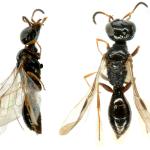Spilomena differens Blüthgen, 1953; Spilomena nikkoensis TSUNEKI 1971; Spilomena pulawskii DOLFUSS 1983
There is some taxonomic uncertainty regarding this, and other, Spilomena species. Here, in line with BWARS, we are currently taking the stance held by Dollfuss (1991) that this species is synonymous with S. differens Blüthgen. However, Lomholdt (1984), Vikberg (2000) and Bitsch et al. (2001) treat the two as separate species. It would be useful to determine whether or not British specimens conform to the curruca sensu stricto or differens s.s. types, should each be promoted to true species in the future.
Records are concentrated in south-east and central England, with only a very thin scattering of records from northern England and eastern Scotland. Richards (1980) cites Dublin, but the record is not precise enough to map.
Restricted to central and northern Europe, being on the western edge of its range in the UK. However, descriptions of European distributions are based on the species split described above. Lomholdt (1984) considers this species to be found only in Fennoscandia and Soviet Karelia (with Spilomena differens described as having a nondescript European distribution). Bitsch et al. (2001) say Spilomena curruca has been recorded from Germany, Austria, Poland and Scandinavia but NOT England, whereas Spilomena differens is given a broader distribution through central and northern Europe, including England.
Bitsch et al. (2001) suggest that their Spilomena curruca may have a boreo-montane distribution and there may be some degree of geographical/climatic separation, with curruca occupying more northerly and/or montane habitats than differens, a view supported by Vikberg (2000). This might then lead to a suggestion that the Scottish specimens mapped here might be a different “form” or species to those specimens from the south-east of England. Closer examination of specimens from northern England and Scotland would be useful in this respect.
This species is not regarded as scarce or threatened.
Currently BWARS refers to Vikberg's 2000 treatment of Spilomena
V. V. Vikberg, “A re-evaluation of five European species of Spilomena with a key to European species and relevance to the fauna of North Europe, especially Finland (Hymenoptera: Pemphredonidae)”, Entomologica Fennica, vol. 11, pp. 35-55, 2000.
Likely to be found in a wide range of habitats where its nest sites are available, including the timbers of old houses, fences etc. as well as old burrows of wood-worm beetles in dead trees.
June to September.
Blüthgen (1953) cites a female carrying the nymph of a psyllid bug (Hemiptera: Psyllidae). Richards (1980) cites thrips, although this may be a generalisation from the genus as a whole.
Nests in hollow plant stems or old burrows in wood, including dead willow trunks.
No data available.
No data available.
2016


